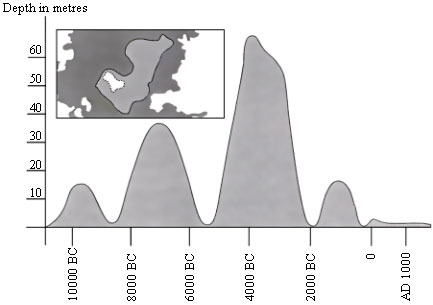Figure A shows changing levels of Lake Chad, in Saharan North Africa. Lake Chad disappeared completely in about 20000 BC, during the last Ice Age. In about 11000 BC it reappeared. Today, its level is about the same as it was in AD 1000.
Figure A
Lake Chad: changing levels

Figure B shows Saharan rock art (ancient drawings or paintings found on the walls of caves) and changing patterns of wildlife.
Figure B
Saharan rock art and changing patterns of wildlife

Source: Copyright Bartholomew Ltd, 1988. 'The Times Atlas of Archaeology', Harper Collins Publishers.
1. What is the depth of Lake Chad today?
(A) About two metres.
(B) About fifteen metres.
(C) About fifty metres.
(D) It has disappeared completely.
(E) The information is not provided.
2. In about which year does the graph in Figure A start? ____________
3. Why has the author chosen to start the graph at this point?
(B) the artists who drew the animals were highly skilled.
(C) the artists who drew the animals were able to travel widely.
(D) there was no attempt to domesticate the animals which were depicted in the rock art.
(B) in the middle of the period when Lake Chad was at its highest level.
(C) after the level of Lake Chad had been falling for over a thousand years.
(D) at the beginning of an uninterrupted dry period.

